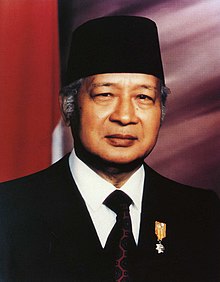Background
From the late 1950s, political conflict grew and the economy deteriorated. By the mid-1960s, annual inflation ran between 500–1,000%, export revenues were shrinking, infrastructure crumbling, and severe poverty and hunger were widespread. President Sukarno led his country in a military confrontation with Malaysia while stepping up revolutionary and anti-western rhetoric.Sukarno's position came to depend on balancing the increasingly hostile forces of the army and Communist Party of Indonesia (PKI). By 1965 at the height of the Cold War, the PKI penetrated all levels of government. With the support of Sukarno, the party gained increasing influence at the expense of the army, thus ensuring the army's enmity. By late 1965, the army was divided between a left-wing faction allied with the PKI, and a right-wing faction that was being courted by the United States.
 |
| As Major General, Suharto (at right, foreground) attends funeral for assassinated generals 5 October 1965. |
Upon being told of the shootings and disappearances, Suharto went to Kostrad headquarters just before dawn from where he could see soldiers occupying Merdeka Square. He led Kostrad in seizing control of the centre of Jakarta, capturing key strategic sites. Suharto announced over the radio at 9:00 pm that six generals had been kidnapped by "counter-revolutionaries". He said he was in control of the army, and that he would crush the 30 September Movement and safeguard Sukarno. Suharto issued an ultimatum to Halim Air Force Base, where the G30S had based themselves and where Sukarno (the reasons for his presence are unclear and were subject of claim and counter-claim), General Omar Dhani and Aidit had gathered. The coup leaders fled Jakarta while G30S-sympathetic battalions in Central Java quickly came under Suharto control.
The poorly organised and coordinated coup thus failed, and by 2 October, Suharto's faction was firmly in control of the army. Sukarno's obedience to Suharto's 1 October ultimatum to leave Halim changed all power relationships. Sukarno's fragile balance of power between the military, political Islam, communists, and nationalists that underlay his "Guided Democracy" was collapsing. Complicated and partisan theories continue to this day over the identity of the attempted coup's organisers and their aims. The army's (and subsequently the "New Order's") official version was that the PKI was solely responsible. Other theories include Suharto being behind the events; that the army and Suharto was merely taking advantage of a poorly executed coup; and that Sukarno was behind the events (see 30 September Movement).
A military propaganda campaign convinced both Indonesian and international audiences that it was a Communist coup, and that the murders were cowardly atrocities against Indonesian heroes. The army led a campaign to purge Indonesian society, government and armed forces of the communist party and leftist organisations. The purge quickly spread from Jakarta to much of the rest of the country. In some areas the army organised civilian and religious groups and local militias, in other areas communal vigilante action preceded the army. The most widely accepted estimates are that at least half a million were killed. As many as 1.5 million were imprisoned at one stage or another. As a result of the purge, one of Sukarno's three pillars of support, the Indonesian Communist Party, was effectively eliminated by the other two, the military and political Islam.
Power struggle
On 2 October, Suharto accepted Sukarno's order to take control of the army on Suharto's condition that he personally have authority to restore order and security. The 1 November formation of Kopkamtib (Komando Operasi Pemulihan Keamanan dan Ketertiban, or Operational Command for the Restoration of Security and Order), formalised this authority.By January 1966 the PKI, President Sukarno's strongest pillar of support, had been effectively eliminated, the army now saw its opportunity to occupy the apex of Indonesian power.Sukarno was still the Supreme Commander by virtue of the constitution, thus Suharto was careful not to be seen to be seizing power in his own coup. For eighteen months following the quashing of the 30 September Movement, there was a complicated process of political manoeuvers against Sukarno, including student agitation, stacking of parliament, media propaganda and military threats.
On 1 February 1966, Sukarno promoted Suharto to the rank of Lieutenant General. The same month, General Nasution had been forced out of his position of Defence Minister, and the power contest had been reduced to Suharto and Sukarno. The Supersemar decree of 11 March 1966 transferred much of Sukarno's power over the parliament and army to Suharto, ostensibly allowing Suharto to do whatever was needed to restore order. On 12 March 1967, Sukarno was stripped of his remaining power by Indonesia's provisional Parliament, and Suharto was named Acting President. Sukarno was placed under house arrest; little more was heard from him, and he died in June 1970. On 27 March 1968, the Provisional Peoples Representative Assembly formally appointed Suharto for the first of his five-year terms as President.
The "New Order" (1967–1998)
Continue Read Part IV



0 komentar:
Posting Komentar
Leave a comment